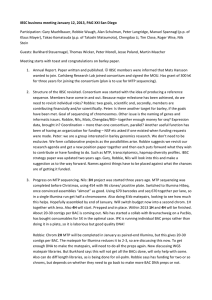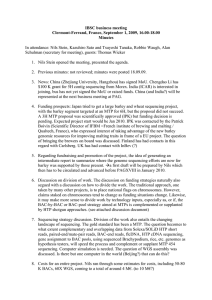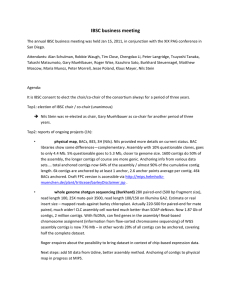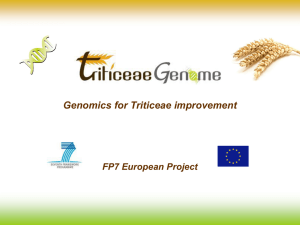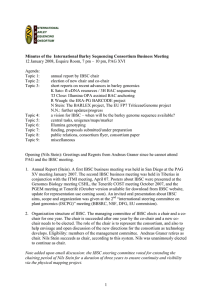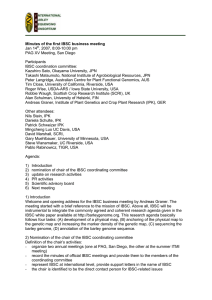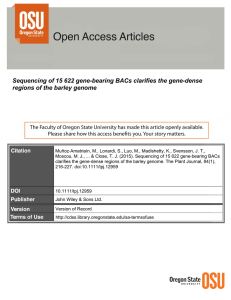IBSC Business meeting 10.01.09, PAG, San Diego. Æ = Action points
advertisement
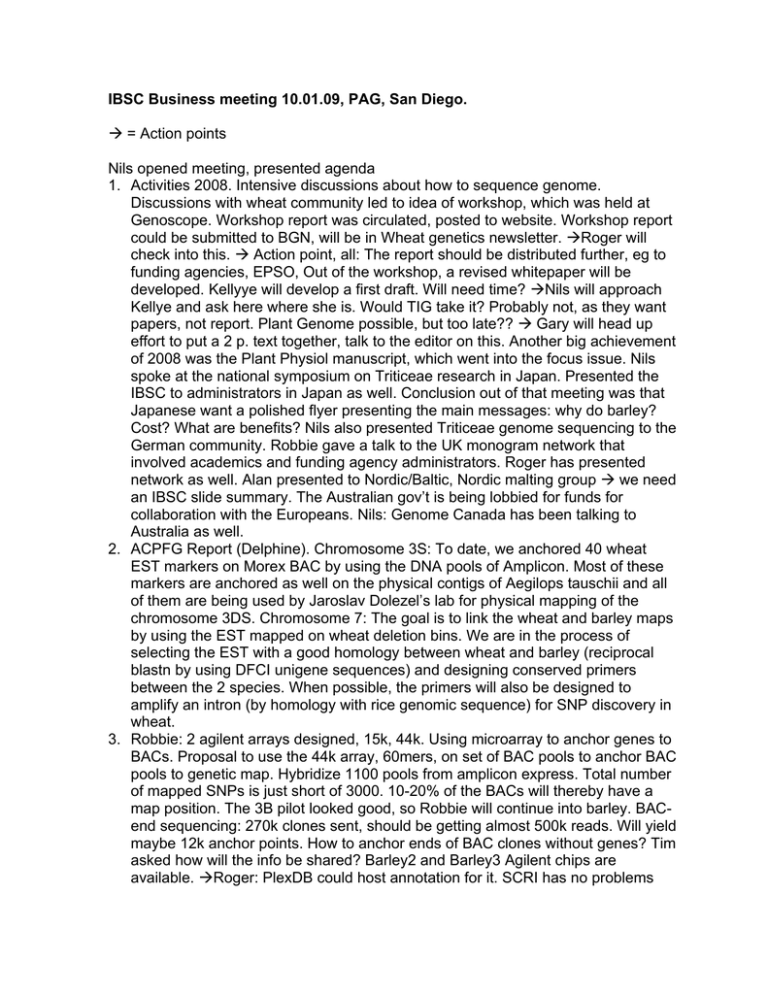
IBSC Business meeting 10.01.09, PAG, San Diego. Æ = Action points Nils opened meeting, presented agenda 1. Activities 2008. Intensive discussions about how to sequence genome. Discussions with wheat community led to idea of workshop, which was held at Genoscope. Workshop report was circulated, posted to website. Workshop report could be submitted to BGN, will be in Wheat genetics newsletter. ÆRoger will check into this. Æ Action point, all: The report should be distributed further, eg to funding agencies, EPSO, Out of the workshop, a revised whitepaper will be developed. Kellyye will develop a first draft. Will need time? ÆNils will approach Kellye and ask here where she is. Would TIG take it? Probably not, as they want papers, not report. Plant Genome possible, but too late?? Æ Gary will head up effort to put a 2 p. text together, talk to the editor on this. Another big achievement of 2008 was the Plant Physiol manuscript, which went into the focus issue. Nils spoke at the national symposium on Triticeae research in Japan. Presented the IBSC to administrators in Japan as well. Conclusion out of that meeting was that Japanese want a polished flyer presenting the main messages: why do barley? Cost? What are benefits? Nils also presented Triticeae genome sequencing to the German community. Robbie gave a talk to the UK monogram network that involved academics and funding agency administrators. Roger has presented network as well. Alan presented to Nordic/Baltic, Nordic malting group Æ we need an IBSC slide summary. The Australian gov’t is being lobbied for funds for collaboration with the Europeans. Nils: Genome Canada has been talking to Australia as well. 2. ACPFG Report (Delphine). Chromosome 3S: To date, we anchored 40 wheat EST markers on Morex BAC by using the DNA pools of Amplicon. Most of these markers are anchored as well on the physical contigs of Aegilops tauschii and all of them are being used by Jaroslav Dolezel’s lab for physical mapping of the chromosome 3DS. Chromosome 7: The goal is to link the wheat and barley maps by using the EST mapped on wheat deletion bins. We are in the process of selecting the EST with a good homology between wheat and barley (reciprocal blastn by using DFCI unigene sequences) and designing conserved primers between the 2 species. When possible, the primers will also be designed to amplify an intron (by homology with rice genomic sequence) for SNP discovery in wheat. 3. Robbie: 2 agilent arrays designed, 15k, 44k. Using microarray to anchor genes to BACs. Proposal to use the 44k array, 60mers, on set of BAC pools to anchor BAC pools to genetic map. Hybridize 1100 pools from amplicon express. Total number of mapped SNPs is just short of 3000. 10-20% of the BACs will thereby have a map position. The 3B pilot looked good, so Robbie will continue into barley. BACend sequencing: 270k clones sent, should be getting almost 500k reads. Will yield maybe 12k anchor points. How to anchor ends of BAC clones without genes? Tim asked how will the info be shared? Barley2 and Barley3 Agilent chips are available. ÆRoger: PlexDB could host annotation for it. SCRI has no problems with this. 105k: all barley unigenes in both directions. 54 k informative 9k still left out . 44k Kaz: full-length cDNA library, several papers on this are in revision. Kaz400 BACs from 3H, fl cDNA finished, 5k public, 20k to come. Will these be available? Gene sequences could be sent as a query, Japanese will look to see if this is available. Tim: now on a mission to get publications out: mapping paper, BAC pooling and deconvolution; whole-genome applications; BAC address gathering, hybridization data. USDA has opportunity for “structural genomics….” For 1 MUSD. Two years, 500k per year. Solexa sequencing on BACs—but cheaper to do tagged BACs in pools. Tim will apply to use the pools and do another region of the genome, using gene list. Question of what chromosome to go after – not 1 & 3, which are in Europe, but maybe 5. Roger: map of 1500 responding genes in infection. Being written up. Kaz: development of deletion stocks in 3H. Nils: physical map HICF passed 8x coverage; 1000 BACs 454 sequenced as barcoded pools to 15-20x coverage; barley 1H sorted and survey sequenced to 1.3x coverage by 454 GSFLX. 4. Membership requests Æ to be handled by email by Nils. 5. Nomenclature – maize people have this under control. We take same approach? 6. New proposals: q of what the JGI will do. Whether it will pick up more sequencing. JGI wants simple approaches, not tagged BACs. Will methyl filtering go? + Illumina paired-end read data, for gene discovery? Peter. 3H and 7H. Nils, MTP sequencing, in review. GABI is in renewal phase. 7. Website, flyer: What to add? Structure like the wheat site? Needs to be made more current in style? Flyer: Nils has contact with a professional designer that wants 2.5k. They need text and images. ÆIPK will take lead on flyer. 8. AOB: ITMI/COST meeting. Next business meeting there.
